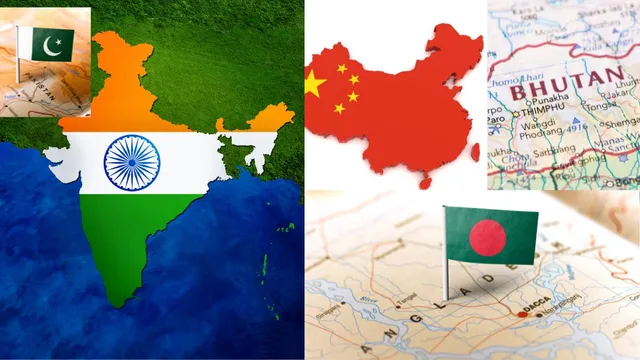- By Aditi Priya Singh
- Wed, 07 May 2025 11:50 AM (IST)
- Source:JND
List Of India's Neighbouring Countries And Its Relation With Them: India’s relations with its neighbouring countries have always been of great importance, especially when it comes to maintaining peace, trade and border security. From the complex relationship with Pakistan to the strong bonds with Bhutan and Myanmar, India's neighbourhood policy plays a significant role in shaping its foreign relations. In this context, understanding India's relationships with its neighbours, including China, Nepal, Sri Lanka, and others, is essential for grasping the country's position in the region.
However, recent events have heightened tensions, particularly with Pakistan. After the Pahalgam terror attack, which claimed the lives of 26 Indian civilians, the Indian government responded strongly with Operation Sindoor, targeting terror bases in POK. In a bold move, India also carried out air strikes on Pakistan-based terrorist camps, sending a strong message against cross-border terrorism.
List Of India's 9 Neighbouring Countries And It's Relationship With Them
Amid such developments, it becomes essential to understand how India manages its relations with neighbouring nations like China, Bangladesh, Bhutan, Nepal, Sri Lanka and others, balancing cooperation, conflict and diplomacy.
1. India-Pakistan Relations
India and Pakistan share a highly militarised border of about 3,323 kilometres. The Kashmir dispute and frequent terror attacks are the main causes of their complicated and frequently antagonistic relationship. The two nations have a history of conflict and have fought in multiple wars. Despite India's efforts to keep them amicable under its "Neighbourhood First Policy", the Kashmir dispute and Pakistan's alleged support for terrorism continue to strain relations. India places a strong emphasis on peaceful, bilateral conflict resolution.
2. India-China Relations
China and India share a 3,488-kilometre border in the Himalayan region. Since the second century BC, the two nations have maintained cultural and commercial relations. However, border disputes have caused tensions in their relationship, especially since the Sino-Indian War in 1962. Tensions still exist despite efforts to normalise relations, particularly in Ladakh and Arunachal Pradesh along the Line of Actual Control (LAC). Since 2004, economic relations have improved as both nations work to address border disputes. The goal of frequent high-level visits and diplomatic initiatives is to strengthen ties.
3. India-Bangladesh Relations
India and Bangladesh share a 4,096-kilometre border, which is the longest India shares with any country. The two nations' relations have grown stronger despite early difficulties after Bangladesh gained its independence in 1971. To streamline their border, they exchanged enclaves in a historic land boundary agreement signed in 2015. India improves connectivity and trade by offering transit routes through Bangladesh to its northeastern states. With an emphasis on security, cultural exchanges and economic cooperation, bilateral relations have greatly improved.
4. India-Nepal Relations
India and Nepal share an open border of about 1,751 kilometres. Economic, cultural and historical ties form the foundation of their relationship. The two nations have agreements related to trade, transit, and several other areas of cooperation. Good relations are maintained through frequent diplomatic efforts and visits, although occasional border disputes and issues related to trade and hydropower projects arise. Rail freight transit between the two countries is governed by the Rail Services Agreement (RSA) 2004.
5. India-Myanmar Relations
The border between India and Myanmar is 1,643 kilometres long. The goal of their relationship is to strengthen strategic and economic alliances in line with India's "Look East Policy" and "Act East Policy." Enhancing connectivity between eastern India and Myanmar is the goal of the Kaladan Multi-Modal Transport Project. With frequent high-level visits to fortify ties, cooperation in fields like trade, security, and cultural exchanges is expanding.
6. India-Bhutan Relations
India and Bhutan share a 699-kilometre border and their relationship is about Cooperation, friendship, and mutual trust define their relationship. Their bilateral relations are based on the 1949 Treaty of Friendship and Cooperation, which was modified in 2007. A key component of their economic partnership, hydropower projects are one area in which India supports Bhutan's socioeconomic development. Scholarships for education and cultural exchanges deepen their relationship.
7. India-Sri Lanka Relations
India and Sri Lanka share a maritime border and they also have had close cultural, intellectual and religious ties for more than 2,500 years. Bilateral trade is encouraged by the India-Sri Lanka Free Trade Agreement (ISFTA). Joint military exercises like "Mitra Shakti" and "SLINEX" demonstrate the importance of defence cooperation. India backs Sri Lanka's development programs, especially those that benefit internally displaced people. India and Sri Lanka are maritime neighbours, even though they do not share a land border. Historically, there have been close cultural and religious ties. Despite problems like Tamil refugee concerns, trade and investment ties are expanding.
8. India-Maldives Relations
India and the Maldives share maritime ties and have ancient ethnic, linguistic, and cultural ties. They have close, cordial and complex relationships. In 1965, India was one of the first countries to acknowledge the independence of the Maldives. Strong diplomatic ties exist, with collaboration in development, trade, and security. India supports the infrastructure and security requirements of the Maldives.
9. India-Afghanistan Relations
India and Afghanistan have the shortest border distance, which is 106 Km long is located in the Ladakh region of the Union Territory of Ladakh. India's relations with Afghanistan focus on economic, technical, and cultural cooperation. India provides significant development aid, including infrastructure projects, institutional capacity building, and food security support. Aviation connectivity between the two countries has improved, reflecting their growing bilateral ties.

